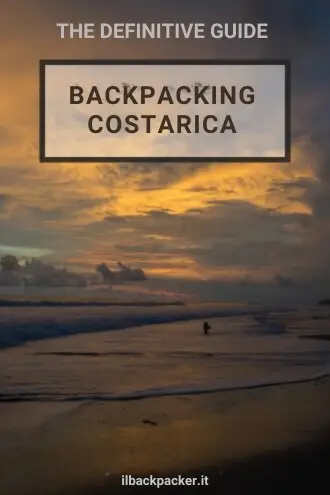Costa Rica Travel Guide
Costa Rica has historically been one of the most visited countries in Central America. It is a nation rich in flora and fauna, featuring beautiful beaches, volcanoes, and truly hospitable people. Additionally, it boasts one of the oldest democracies in the world, setting it apart from other countries in the region.
In short, Costa Rica has been a popular destination for mass tourism for years. Travel is extremely easy, and the tourism infrastructure is well developed. However, the other side of the coin is the cost; for those traveling on a small budget, Costa Rica is notoriously the most expensive country in all of Central America. Despite this, it remains an impressive destination.
In this guide, you’ll find many useful tips for planning your trip to Costa Rica, always with an eye on the budget.
Quick menu
- When to visit Costa Rica
- Documents and vaccinations to enter Costa Rica
- What to do and see in Costa Rica
- Suggested itineraries in Costa Rica
- How to get around Costa Rica
- Backpacking Costa Rica: costs
- Backpacking Costa Rica: safety
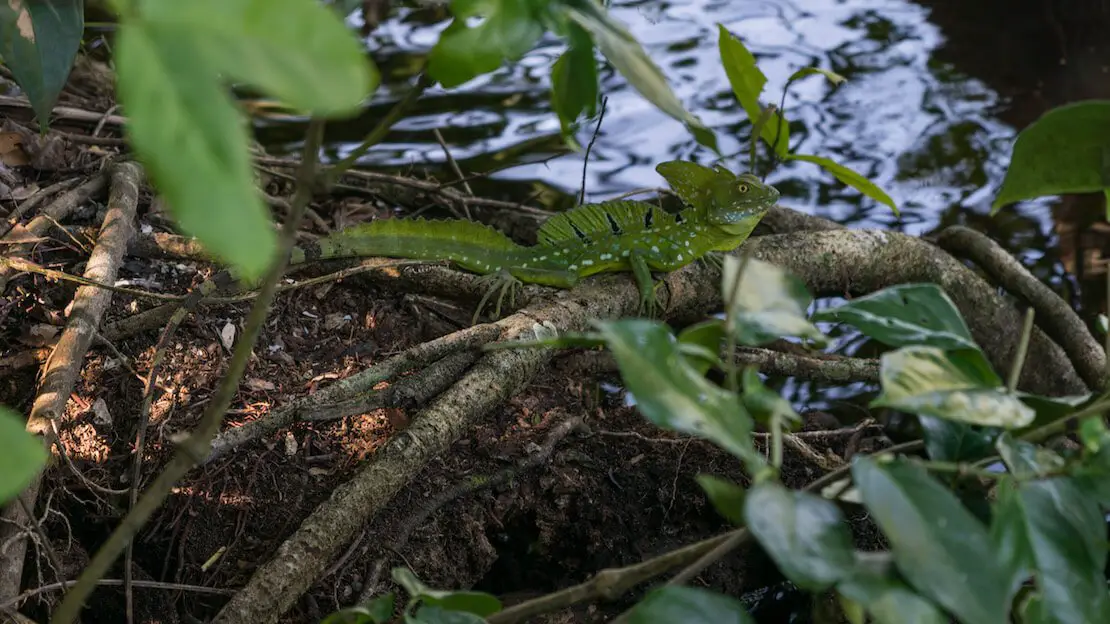
Male green basilisk lizard, Cahuita National Park.
When to visit Costa Rica
Temperatures in Costa Rica can vary greatly depending on altitude, creating a range of microclimates. The climate is particularly unpredictable in mountainous areas, but you can still identify two distinct seasons:
The dry season runs from mid-November through April. During this period, there is almost no precipitation, clear skies, and excellent temperatures.
The rainy season runs from May to mid-November. Rainfall is heaviest during September and October, often concentrated in the afternoon, while mornings are typically sunny.
The best times to visit Costa Rica are November, April (after Easter), and May, when the rains are just over or just beginning. During these months, nature is lush, and prices are lower than during the high season, which runs from December to March.
That said, I personally visited the country in June, during the rainy season. Perhaps I was lucky, but the weather was certainly not bad. The only two months best avoided, if possible, are September and October.

Documents and vaccinations to enter Costa Rica
Most passport holders receive a free 90-day tourist visa upon entering the country. You can do the classic “visa run,” which means leaving and re-entering the country to get another 90 days, practically indefinitely if you’re interested. I have met people who have been doing this for decades.
Vaccinations for Hepatitis A and B are recommended. Although Yellow Fever is not present in the country, certification is mandatory if you come from or have recently (within the last six days) visited a Yellow Fever risk country, such as much of South America and Central Africa.
This is the official immigration website.
What to do and see in Costa Rica
Let us briefly discuss the currency situation, as you will often find references to prices in this guide. The local currency, the Colón (CRC), is the official one, but in practice, there is another unofficial official currency: the U.S. dollar.
The U.S. dollar is accepted almost everywhere, can be withdrawn from ATMs, and is often used as the official currency for tourist activities. I recommend carrying both currencies. When dealing with transportation, food, and local businesses, it is more convenient to pay in Colón because, although the dollar is accepted, it is often given an unfavorable exchange rate. However, for paying for hostels, hotels, tours, and park entrances, the dollar is often cheaper.
At the time of publication, the exchange rate is 1€ = 656 CRC and 1$ = 572 CRC. For the current exchange rate, I suggest you check this page.
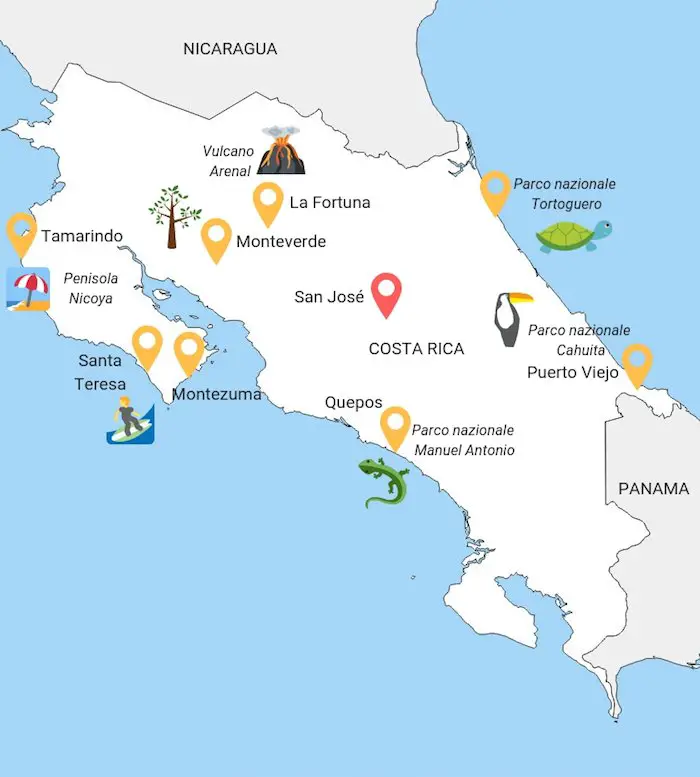
N.b. Several times throughout the guide, you will find links to https://www.alltrails.com/. Upgrade to the pro version if you want offline navigation directly from the Alltrails app. However, you can get around this by downloading the coordinates from the site’s desktop version in “Google Earth KML” format and then uploading them to organic maps, which is by far one of my favourite travel apps.
Puerto Viejo
Puerto Viejo is now a permanent fixture on the itinerary of a Costa Rica trip. With its beaches, palm trees, good surfing, and laid-back atmosphere, it attracts thousands of travelers each year. Located on the Caribbean coast, about an hour south of Limon, it serves as an excellent base for exploring the nearby Cahuita National Park and is a convenient stop if you’re traveling north from Panama.
What to do and see in Puerto Viejo
There are plenty of beaches, and in the evening, although the town is relatively small, there are numerous bars and restaurants along the main street. In case you are interested, some of the beaches nearby have excellent surfing conditions!
Cahuita National Park
Cahuita National Park is only a 15-20 minute bus ride north of Puerto Viejo and is undoubtedly one of the best places to see the incredible nature this country has to offer. The park has two entrances: the main one from the small town of Cahuita (Google Maps) where entry is by voluntary donation and a second entrance from Puerto Vargas (Google Maps) where the cost is $5 – It does not make sense but there it is!
The two approaches are connected by a well-marked and maintained trail that alternates between the forest and the beach. Along these 8 km (All Trails) if you pay attention you can see a lot of animals. I saw monkeys, giant lizards, a caiman, a group of raccoons and an iguana. Playa Blanca (Google Maps), one of the two beaches crossed by the trail, is really pretty and swimming is allowed.
I recommend spending the whole day inside the park and following the trail from start to finish, the bus to take is the one heading to Limon which should leave every hour or so, the Puerto Vargas access stop is along the main road while to enter from Cahuita you’d better get off once you get to the terminal, the bus costs about $1.5 each way.
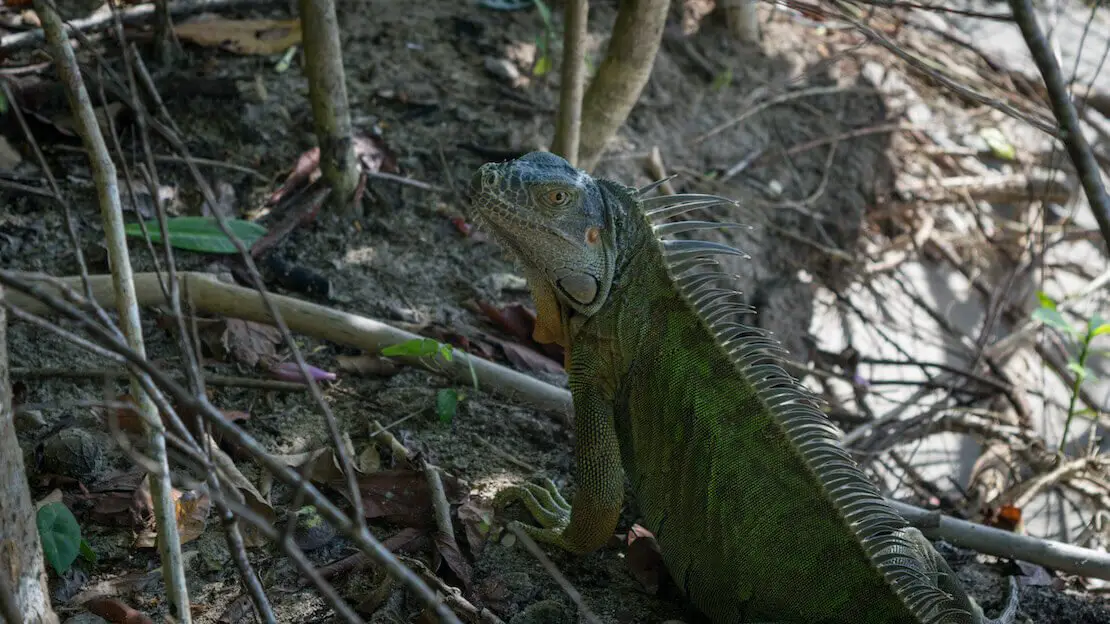
Iguana on the beach at Cahuita Park.
Rent a bike
Numerous hostels rent bikes for about $5 a day. The almost completely flat stretch of coastal road, just under 15 km long, leading to Playa Manzanillo (Google Maps) is extremely popular to ride as the road ends at this point and there is very little traffic.
Along the way there are numerous beaches where you can stop. The most popular and pretty are Playa Cocles (Google Maps), Playa Chiquita (Google Maps) and Punta Uva (Google Maps). Just outside Puerto Viejo, in the direction of Manzanillo, there is a wildlife rescue center (Google Maps) that offers guided tours of about an hour and a half – at 9:30 a.m. and 11:30 a.m. Monday through Saturday and the cost is $27. I was told that the center is really nice and the money is donated to a good cause. This is the website.
Where to sleep in Puerto Viejo?
It was reported to me that the hostel where I had slept has not reopened since the covid. Therefore I recommend checking out Pagalù Hostel, great reviews and central location. If you don’t mind staying slightly outside the center consider Tasty Dayz Hostel.
How to get to Puerto Viejo?
To and from San Jose there are 6-7 departures per day. If, on the other hand, you arrive or continue your journey to Panama, later in this guide you will find detailed instructions on how to cross the border.
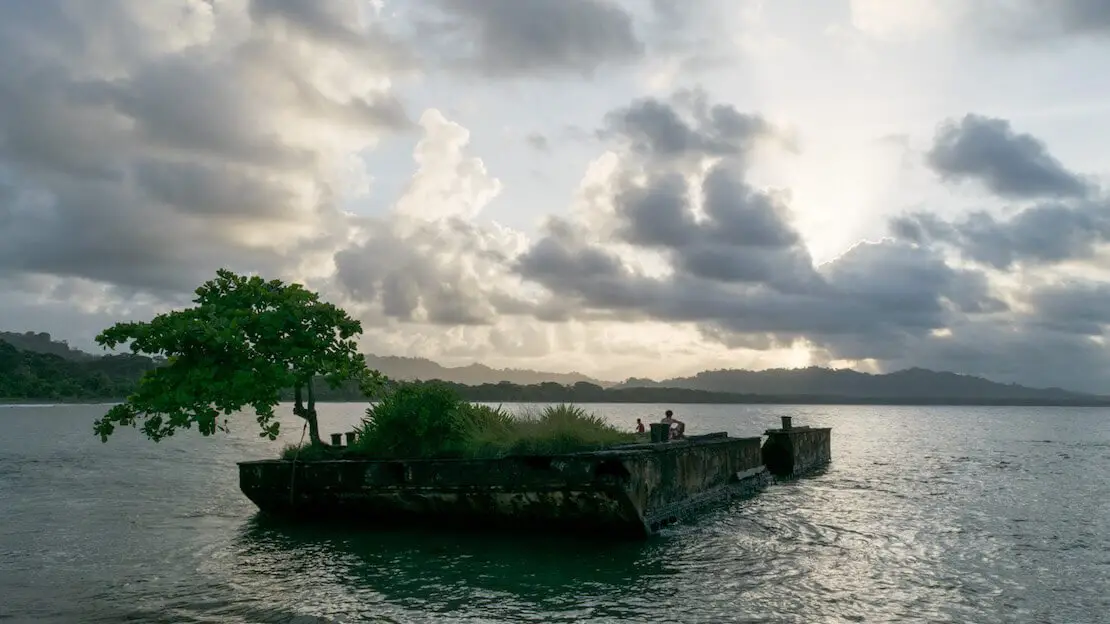
Puerto Viejo.
San José
For many travelers, San José is simply a waypoint to reach the next destination within the country. Due to Costa Rica’s road system, traveling from one coast to another or crossing the country from north to south almost always involves passing through the capital.
I spent only one day in San José, but it gave me the impression that it was much more livable than other Central American capitals. Additionally, being situated at 1,172 meters above sea level, the temperatures are pleasant throughout the year.
Even if you are coming from another country, you will likely pass through San José at some point. Many travelers board a bus directly to their next destination. However, if you have time, spend a few days in the city. Take a stroll downtown and walk along Avenida Central (Google Maps). The area is nice, and there are a couple of museums nearby.
Poás Volcano National Park
There is an interesting day trip you could take starting right from San José: the one to Poás volcano (Google Maps). This is an active stratovolcano with a small sulfuric acid lake inside the crater, and the view is really impressive.
During my visit to Costa Rica the park was closed due to a recent eruption. I encourage you to do your research. To reach Poás Volcano Park, there is only one bus a day so plan accordingly. You can find a detailed guide here.
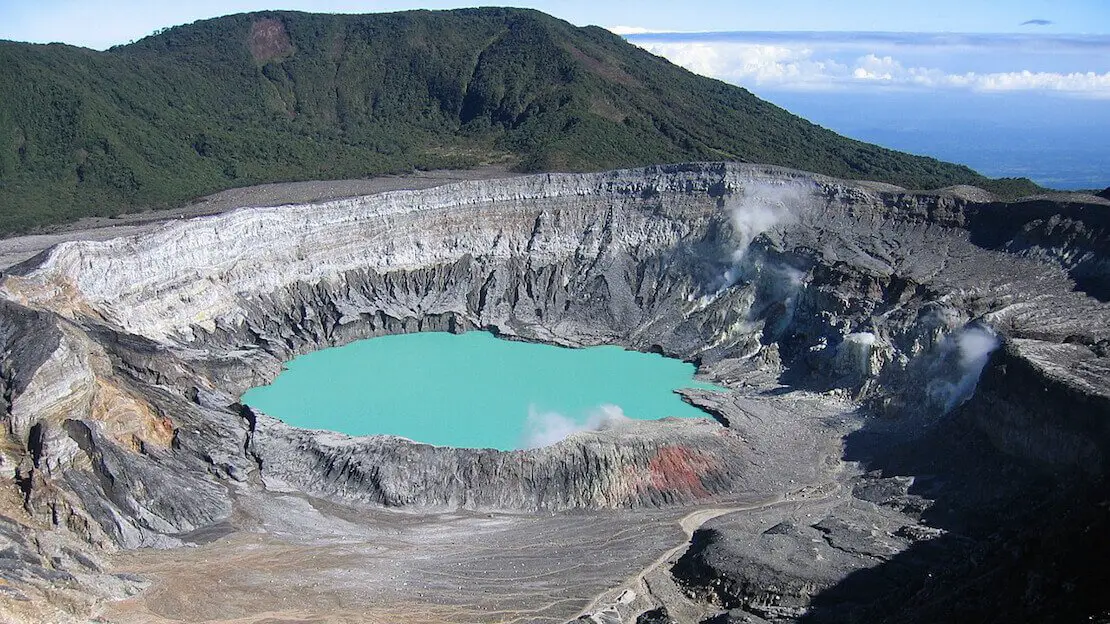
Poás National Park.
Where to sleep in San Jose?
Stray Cat Hostel is a great hostel, clean, cheap, great staff and breakfast included! It is slightly off center, in a residential area a short distance from terminal 7-10 and Caribe terminal, so perfect for saving time and money.
How to reach San Jose?
From the airport there are buses leaving every 5 minutes to downtown San Jose that cost less than $1; a taxy costs $25-30.
From any other city in Costa Rica there are likely direct buses to the capital several times a day. To reach your next destination be careful, however, because unfortunately there are several bus terminals in San José typically divided by the destination region they serve.
Quepos
Quepos is a small town south of San Jose used as a base for exploring the nearby Manuel Antonio National Park. There is not much to do in the village but if you happen to be around on a Friday night or Saturday morning then I suggest you drop by the market (Google Maps) held once a week, you can stock up on fruit at bargain prices and have a typical local experience at the same time. But now to the main attraction.
Manuel Antonio National Park
Manuel Antonio is the smallest national park in the country but undoubtedly one of the most visited because of its beauty and accessibility. There are numerous trails, the most popular is a short hike that leads to Manuel Antonio beach (Google Maps), the beach is really nice with lots of trees for shelter from the sun but it is also the most crowded, you will probably see monkeys and raccoons frolicking on the beach among the visitors.
Many people stop here but I recommend walking the other trails as well (All Trails). The park is home to over 100 species of mammals and 180 species of birds, seeing animals will not be difficult at all, among the most common in addition to the monkeys and raccoons already mentioned are numerous lizards, iguanas, sloths and frogs.
The park is open Tuesday through Sunday from 7:00 a.m. to 4:00 p.m. and admission costs $16. The number of people allowed inside the park at one time is limited, so it pays to go early in the morning and enjoy it to the fullest. To reach it from nearby Quepos, just take one of the buses that leave about every half hour, 305 CRC, about 10 minutes.
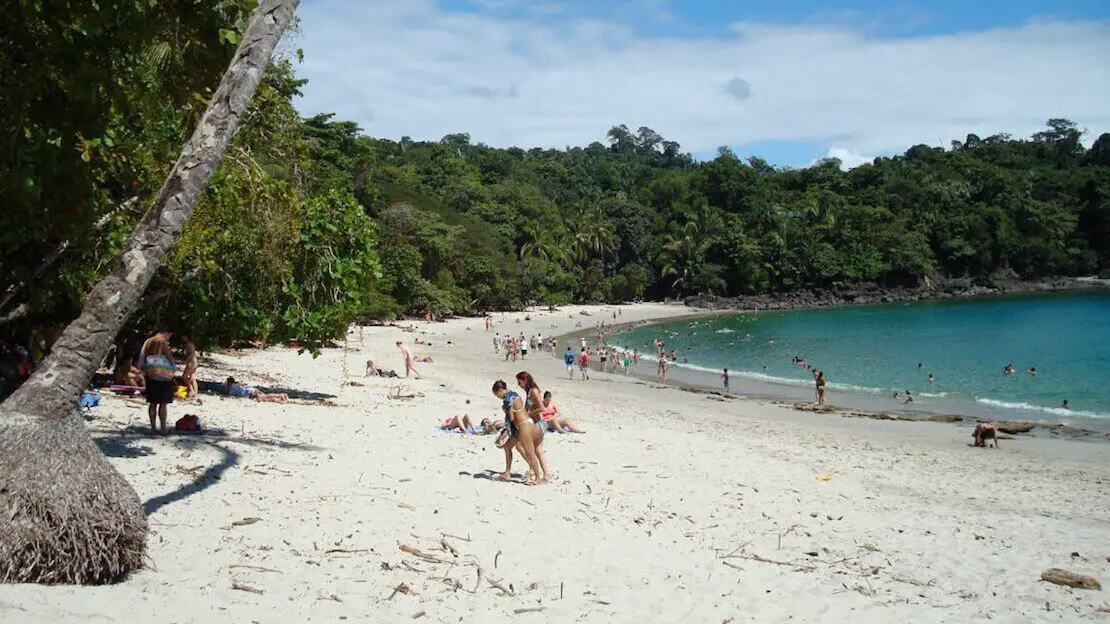
Manuel Antonio beach.
Where to sleep in Quepos?
Passifloras Hostel is a good budget hostel in downtown Quepos but there are plenty of options in and around the village.
How to reach Quepos?
From San Jose, buses leave from Tracopa Bus Terminal (Google Maps). Here you can find detailed information.
Tortuguero
The small town of Tortuguero (literally “turtle region”), located within the national park of the same name, is undoubtedly one of the most remote and wild places in the country. Its beaches are famous for the thousands of turtles that return each year to lay their eggs, making it one of the best places in the world to observe this phenomenon.
Tortuguero National Park
The park can be visited year-round, but it is during the turtle breeding season that in my opinion it is really worth visiting. Practically anyone offers tours to observe this phenomenon for as little as $20; the season runs from April to May for Leatherback turtles and July to October for green turtles. Tours are given in the evening and last on average a few hours.
In addition to the famous beach, the park also includes numerous freshwater canals and lagoons that branch through the lush forest that dominates the area also called the Amazon of Costa Rica. Many lodges and agencies in the country offer boat or canoe tours to observe wildlife including caimans, freshwater turtles, monkeys, numerous bird species and more, again starting at about $20.
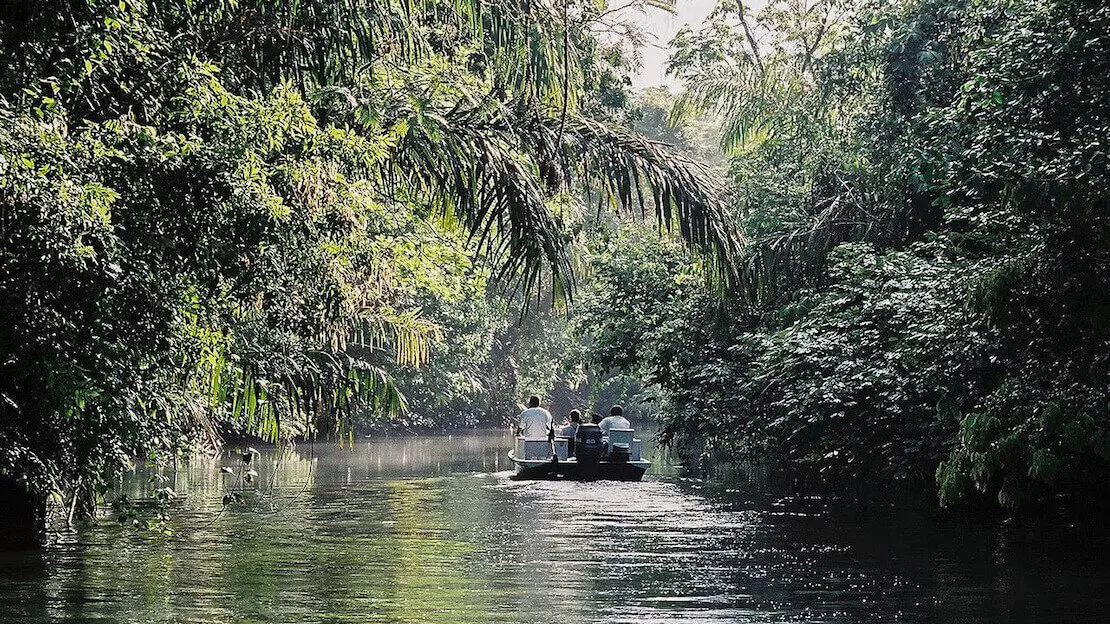
Tortuguero National Park boat tour.
Where to sleep in Tortuguero?
Cabinas Tortuguero is a good inexpensive hostel but there are a lot of options, including lodges completely surrounded by forest that look really nice.
How to reach Tortuguero?
As mentioned above, this is a fairly remote place that can be reached by plane (expensive) or by a combination of boat and bus by doing the following.Take the 9:00 am bus from San Jose to Cariari from the Gran Caribe terminal (Google Maps). The bus should arrive in Cariari around 11:00 a.m. and from there you have to take the direct bus to La Pavona which leaves at 11:30 a.m. where there is a boat to transfer to Tortuguero where you arrive around 3:00 p.m. after an hour and a half two hours of sailing. The whole trip costs about $10. To return, follow the instructions in reverse, boats from Tortuguero to La Pavona should leave at 5:30, 11:00 and 14:30 each day.
Monteverde
Monteverde became famous following the publication of an article in National Geographic where it was described as the best place in the world to observe the rare shining Quetzal and has since attracted nature lovers from all over the world. The Monteverde Cloud Forest is one of the most visited places in the country and undoubtedly a destination that is almost always part of the itinerary for a trip to Costa Rica.
Small note: Monteverde includes the entire area consisting of Santa Elena (the main town) and the numerous villages surrounding it.

Monteverde Reserve.
What to do and see in Monteverde
There are several reserves in the area: the Monteverde Nebula Forest, the Santa Elena Nebula Forest, the Bosque Eterno de los Niños “children’s eternal forest” reserve, and Bajo del tigre.
Monteverde Reserve (Google Maps) is the most popular. It has well-maintained trails with numerous viewpoints and a suspension bridge in the middle of the forest. The reserve is open daily from 7am to 4pm Admission costs $20. I recommend hiking this trail.
The Santa Elena reserve (Google Maps) is at a higher elevation and is therefore wetter and more immersed in clouds. Here too there are several trails including one that leads to a nice viewpoint from which you can see the Arenal volcano, assuming it is not too cloudy. The reserve is open daily from 7am to 4pm Admission costs $16. I recommend hiking this trail.
For the two most famous reserves there are direct buses that leave from the village in front of Banco Nacional (Google Maps) 4-5 times a day. You can find the schedule here. I recommend going early in the morning when the trails are less crowded and the animals are more active so the chances of seeing some of them are greater.
As you can see, entry to the reserves is not cheap, and if you want to be accompanied by a guide or participate in an overnight tour the costs increase. For those on a tight budget, I think the Santa Elena reserve is the best option of the three.
Ziplining in Monteverde
This is a fairly expensive activity that I have not personally done but it has been recommended to me by many travelers and is undoubtedly something popular to do in Monteverde. There are four different parks offering ziplining. They all have good reviews and I think it is very subjective but if it helps a dear friend had recommended Selvatura to me (Google Maps). This is the official website, the tour includes 12 ziplines one of which is 2 km long.
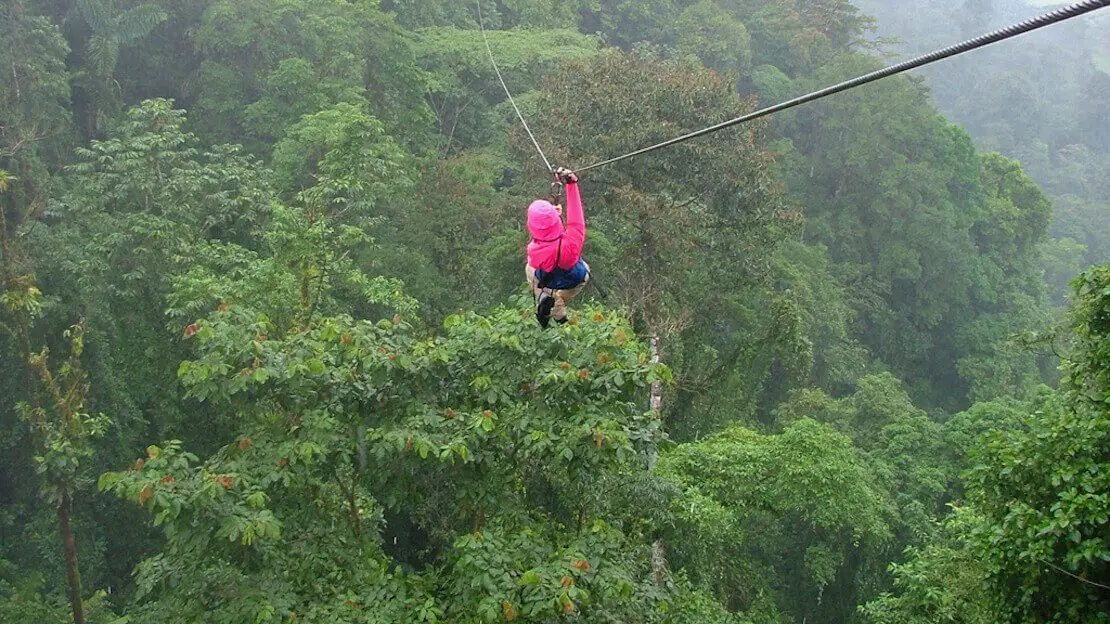
Ziplining in Monteverde.
Where to sleep in Monteverde?
Mi Casa Tica is a very spartan but incredibly cheap hostel and all in all not bad.
How to reach Monteverde?
From San Jose there are two buses a day from terminals 7-10 (Google Maps), at 6:30 a.m. and 2:30 p.m. It is about 5 hours. You can buy your ticket online.
From Nicaragua or northwestern Costa Rica go to Liberia first, from there take the bus to Canas, then Tilaran – > Santa Elena (last bus at 5 pm). Departures are frequent but there are many changes to be made, try to leave early in the morning.
From Puntarenas there are 4 buses: 8:00 am, 1:15 pm, 1:30 pm, 2:15 pm, about 3 hours travel time.
From La Fortuna / Arenal take the 8:00 bus to Tilaran and from there the one to Santa Elena.
La Fortuna
Formally known as Burio it was renamed after the volcano eruption in 1968 that completely leveled 3 villages but miraculously spared el Burio now called La Fortuna. The village is the ideal base for exploring the nearby Arenal Volcano National Park.
What to do and see in La Fortuna
There are plenty of activities to do both inside and outside the national park, such as canyoning, ziplining, horseback riding, visiting waterfalls, and soaking in hot springs, to name a few. You won’t have any trouble finding an agency in the village, although it can be quite expensive.
In fact, the destination is not budget-friendly. The tours offered in the village are really expensive, and getting around the various attractions without your own transportation or a taxi is difficult. This includes reaching the entrance to Arenal National Park. The only bus to the entrance of the national park and back to La Fortuna is the one headed to Tilaran, which drops you off at the intersection leading to the park about 3 km from the entrance. The bus schedule is less than optimal, and a taxi costs about $20.
Tilarán to La Fortuna: 7:00 a.m., 12:15 p.m., 3:30 p.m.
La Fortuna to Tilarán: 6:30 a.m., 11:30 a.m., 3:55 p.m.
Discouraged by other travelers’ stories and the research I did (particularly this article), I decided to skip it. Just to give you an idea: Canyoning costs about $100, access to the famous and crowded La Fortuna waterfall (Google Maps) costs $20, and the many hot springs cost from $35 and up. Anyway the choice is yours, if your budget allows I’m sure the places in question are incredible but I also believe there are other destinations within the country where you can have the same kind of experiences without spending a fortune, especially when it comes to national parks.
Here you can find a very detailed guide about what to do in La Fortuna.
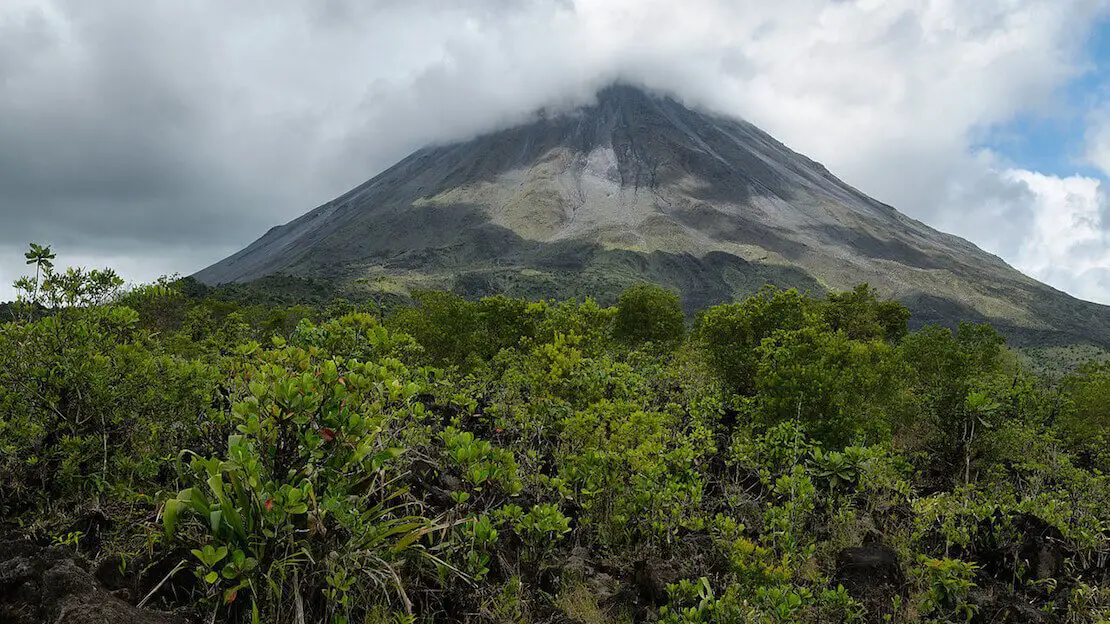
Volcano Arenal, La Fortuna.
How to reach La Fortuna?
From San Jose to terminal 7-10 (Google Maps) there are buses at 6:15, 8:40 and 11:30, which takes about 4 hours. From Monteverde take the 7:00 am bus to Tilaran. From Tilaran take the 12:30 bus to La Fortuna.
Nicoya peninsula
The Nicoya Peninsula is sprinkled with small surfer towns, beautiful beaches, and places still relatively far from mass tourism where mainly only backpackers venture. Traveling within the peninsula can be a slow process as the roads are not well maintained and in places still unpaved.
As just mentioned, the peninsula is extremely popular with surfers or would-be surfers and for those who simply want to see something different from the main tourist destinations in Costa Rica.
Fun fact: The peninsula is a so-called blue zone i.e., a demographic/geographic area where life expectancy is considerably higher than in the rest of the world, in short, a very special place!
But now let’s look at some popular destinations within the peninsula:
Montezuma
Montezuma is likely the most popular destination in the southern part of the peninsula, particularly because it can be reached from San Jose in 4-5 hours. The town has a reputation for having a bit of a hippie vibe, with all that entails. Surfing and partying are very common activities, but there are also some trails in the surrounding area, such as the one leading to Montezuma Waterfall (Google Maps).
Santa Teresa
Santa Teresa is where I spent my time on the Nicoya Peninsula. The town has seen a lot of development in recent years, but it is still just a dirt road with buildings on either side. The conditions for surfing, as well as learning to surf, are great year-round. Even those, like myself, who are not fans of the sport can have a fantastic week enjoying the sea, beach, relaxation, and some of the most spectacular sunsets of their lives.
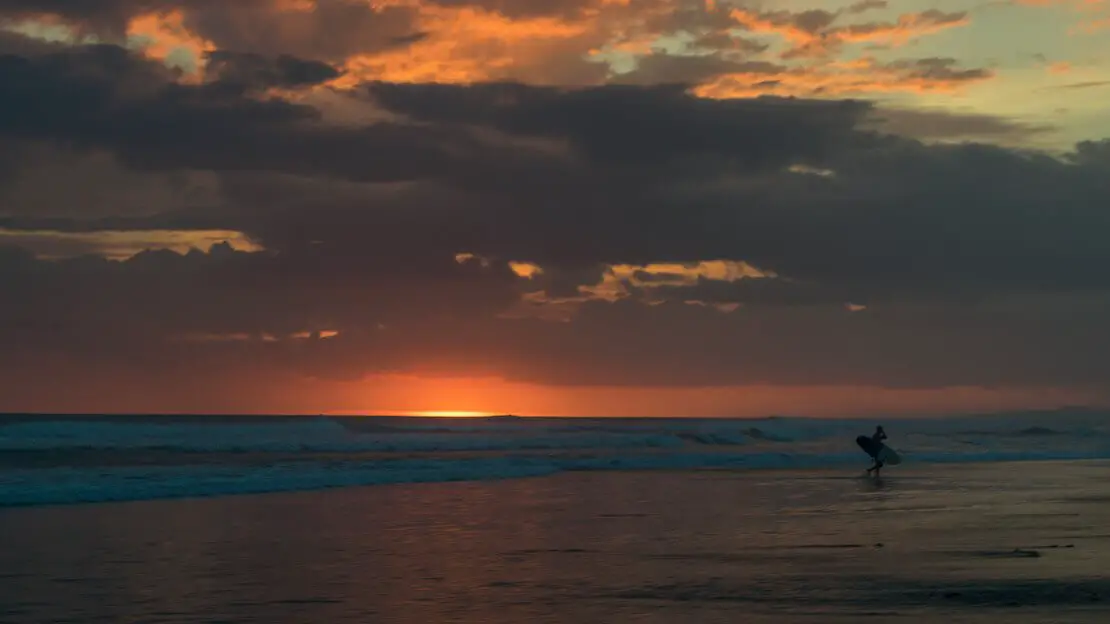
Santa Teresa.
Where to sleep in Santa Teresa?
The hostel where I stayed has been closed. I recommend checking out Casa del Sol and ICO Living Hostel.
How to reach Santa Teresa and Montezuma?
From San Jose the most practical and fastest way to reach Santa Teresa and Montezuma is to take the direct bus from terminal 7-10, departing at 6:00 a.m. and 2:00 p.m., 7545 CRC to Santa Teresa and 7320 CRC to Montezuma, the ferry cost of 800 CRC is included.
If you want to save some money, you could break up the trip. First you have to get to Punta Arenas, from the terminal to the port it’s 5 minutes by taxi or you can walk as I did, about half an hour. The ferries to Paquera from where there are then buses waiting and going to Cobano are at 05:00, 09:00, 11:00, 14:00, 17:00. Once you get to Cobano there are connections to Montezuma and Santa Teresa. Doing it this way saves some money but I don’t think it is worth it, however, if you are not in San Jose it is the only option available. Anyway at this site you can find all the relevant information.
Other destinations in the Nicoya Peninsula
As previously mentioned, there are dozens of possible destinations along the coast of the Nicoya Peninsula. Between Santa Teresa and Montezuma, you could stay in Playa Mal Pais or Manzanillo, a little further north. Both of these locations are still relatively undeveloped.
In the northern part of the peninsula, you will find Samara and Tamarindo. These destinations are much more developed, having become popular earlier and being more easily accessible due to connections from the city of Nicoya, the regional capital. Although I have not personally visited these places, I believe they are more popular destinations for families.
Here you can find an overview of the various destinations.
Other National Parks in Costa Rica
Costa Rica boasts 27 national parks, 30 protected areas, and numerous private reserves. This guide only mentions a few of them. It is unrealistic to visit all these parks in a single trip, especially for independent travelers on a limited budget. Some parks are too expensive to reach or visit. For example, Corcovado National Park requires a guide for access, and others cannot be reached by public transportation.
In my opinion, if you have a limited budget, visiting 2-3 parks is more than enough. You could visit Cahuita or Manuel Antonio among the coastal parks, Santa Elena Reserve in Monteverde to see the cloud forest, and Tortuguero if you are in Costa Rica during the right season. Visiting these 3-4 parks is plenty, but if you get the chance to visit more, that’s even better—I envy you!
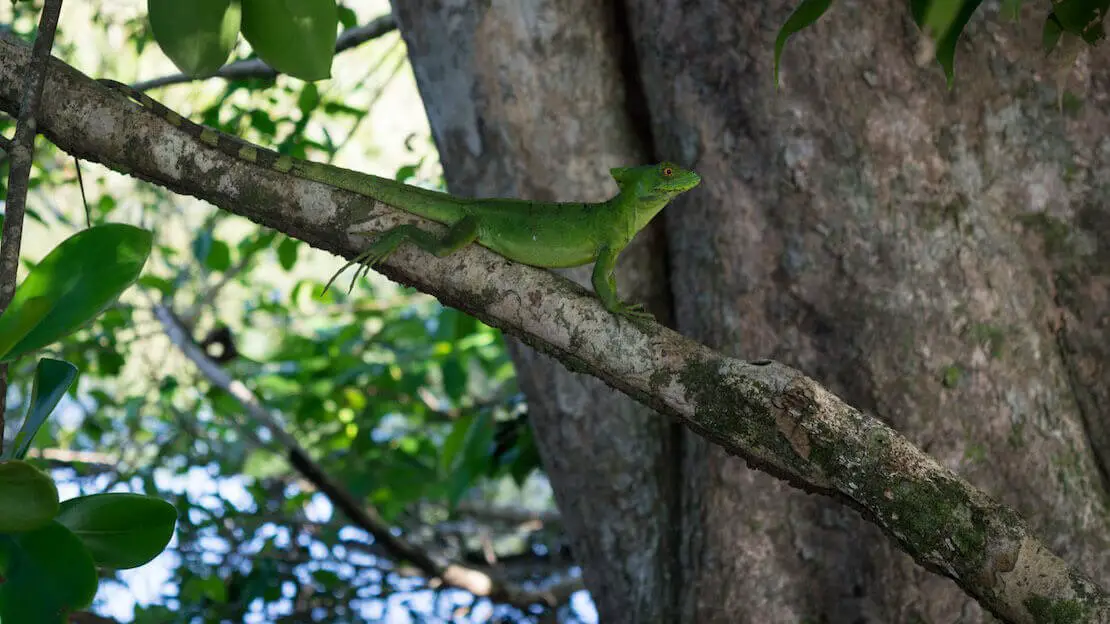
Female green basilisk lizard.
If you found this article helpful, please consider purchasing your travel insurance through one of the links on this site, doing so supports my work at no additional cost to you. For EU & UK Residents, i recommend True Traveller. For everyone else i recommend HeyMondo (5% discount). Thanks!
Crossing the Costa Rica-Nicaragua Border
If you plan to continue your journey to Nicaragua, I recommend first reaching the city of Liberia. There are direct buses to Liberia from San Jose, Puntarenas, Monteverde (via Las Juntas), and many other destinations in northern Costa Rica.
Once you arrive in Liberia, there are buses to Peñas Blancas (the border town) about every half hour from 5 a.m. to 9 p.m. The fare is 1,650 CRC, and the trip takes about 2 hours. After crossing the border, you can easily reach San Juan del Sur, Ometepe, or any other destination in Nicaragua.
Recommended Itineraries in Costa Rica
Below, I list possible itineraries for 10 days, 2 weeks, and 3 weeks. There is no perfect itinerary given a specific time frame, so consider what you have read so far. Take the following suggestions as inspiration and modify the itinerary according to your interests and budget.
10-day itinerary in Costa Rica
Ten days is not a lot of time but it is more than enough time to visit a couple of national parks, with the following itinerary you would visit four, Manuel Antonio and Cahuita have great beaches but if you prefer to spend a few days just on the beach then I suggest you skip a few and head to the Nicoya Peninsula.
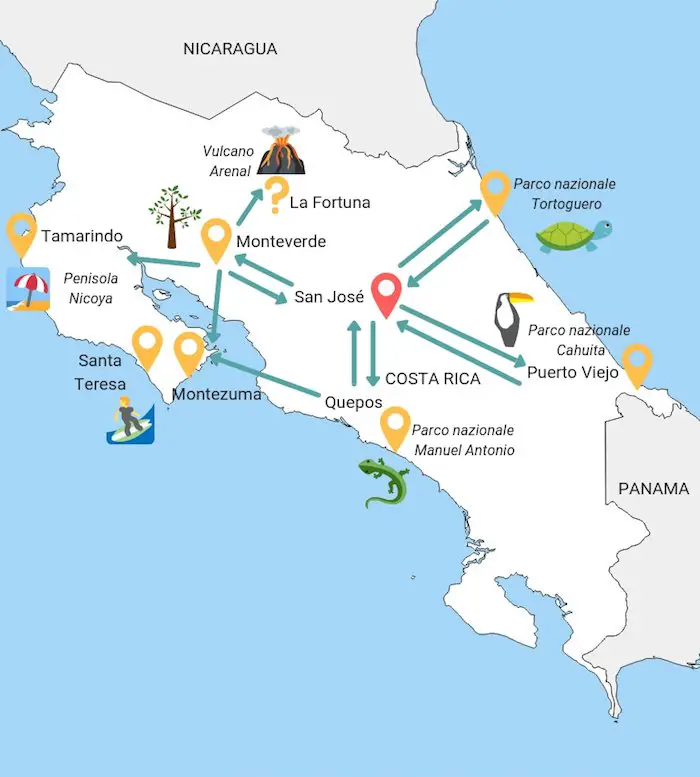
San Jose (1 night)
Day 1:
Recover from Jet Lag, walk through the city center.
Tortuguero (2 nights)
Day 2:
Transfer to Tortuguero. Tour to spot turtles in the evening.
Day 3:
Canoe tours in the forest.
Puerto Viejo (3 nights)
Day 4:
Bus to San Jose. Bus to Puerto Viejo.
Day 5:
Cahuita National Park.
Day 6:
Cycling day along the coast.
Monteverde (3 nights)
Day 5:
Puerto Viejo – San José bus, San José – Monteverde.
Day 6:
Monteverde Reserve or Santa Elena Reserve.
Day 7:
Zipper lining/coffee tour/relaxation day.
Quepos (2 nights)
Day 8:
Bus to San José. Bus to Quepos.
Day 9:
Manuel Antonio National Park.
Day 10:
Return home.
Two-week itinerary in Costa Rica
With two weeks to spare I would not change the itinerary just described by much. You could add a few days in La Fortuna (not exactly a low-cost destination) or in my opinion better a few days at the beach in the Nicoya Peninsula.
20-day itinerary in Costa Rica
Twenty days or three weeks is an ideal amount of time to explore Costa Rica. As always, the itinerary doesn’t change much since you often have to return to San Jose anyway. The 10-day itinerary previously described is a good base to start from. In my opinion, the only two stops to add are the Nicoya Peninsula and, budget permitting, a few days in La Fortuna.
To optimize time, know that from Quepos and Monteverde, there are direct buses to Puntarenas, where you can take the ferry to the southern part of the peninsula without returning to San José. Similarly, from Monteverde, it is possible to reach the northern part of the peninsula (Tamarindo, Samara, etc.) without having to return to San José. This costs about $8 compared to $45 for a shuttle, as described in the comments on this page.
How to get around Costa Rica
Buses in Costa Rica
Buses are undoubtedly the cheapest way to travel within the country and reach virtually every possible destination. The only downside is that almost the entire system is based on routes to and from San José, this often makes the time to reach a given destination considerably longer.
Another not-so-optimal thing is that there is not a single bus terminal in San José; in fact, there are multiple terminals that generally serve a specific region of the country-for example, almost all buses heading to the Caribbean coast leave from the Gran Caribe Terminal.
In any case the main ones are all within a mile radius so you can easily get around on foot, be wary of taxi drivers who will tell you otherwise! Also given the compact size of the country, even if you sometimes need to return to San Jose, you can often reach your next destination within the same day without needing to spend the night in the capital, do your research in advance and you will have no problem.
Generally speaking, in Costa Rica you cannot book bus tickets online. The only way to secure a ticket is to buy it at the station. Departures for particularly busy routes are frequent and you should have no problem securing a seat on board.
To take a look at times and prices, in my opinion the best site is centrocoasting.com (save it as a favorite!) but you can also take a look at this page.
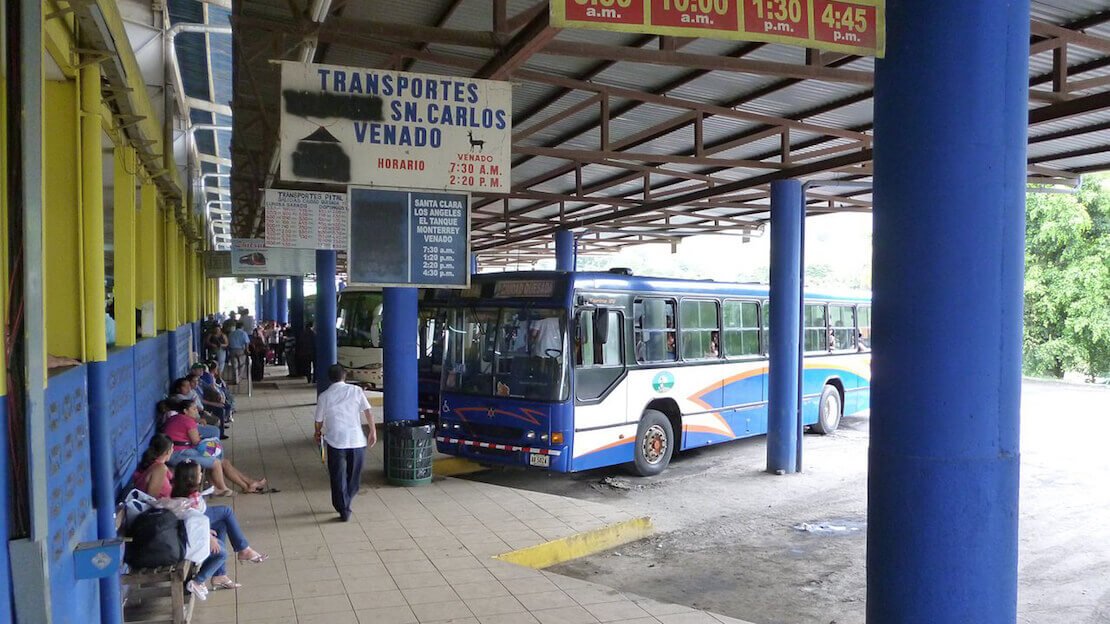
Bus terminal in Costa Rica.
Taxis in Costa Rica
Taxis are available almost everywhere but be careful because it is common practice to charge tourists more than necessary by, for example, extending the route. There are several pirate taxis that would be best avoided, the official ones are red with a yellow triangle on the side and by law are required to use the “Maria” meter for locals.
If you are forced to take an unofficial taxi, be sure to establish the price before you leave to avoid unnecessary arguments upon arrival at your destination. It’s always a good idea to ask your lodging or a local resident for the typical fare for a particular route. For the time being, Uber only works in San Jose.
Domestic Flights in Costa Rica
There are only two companies that operate domestic flights in Costa Rica. NatureAir and Sansa.
Hitchhiking in Costa Rica
Hitchhiking is an extremely common and safe practice especially in rural areas. Costa Ricans are generally nice and helpful people, if this is your way of getting around you should not have any particular difficulties in Costa Rica.
Backpacking Costa Rica: costs
How much does a trip to Costa Rica cost? Not cheap, unfortunately Costa Rica is really very expensive especially when compared to other neighboring countries. That being said, It is still relatively cheap when compared to European standards. Even as a backpacker I would budget at least 40€ per day.
Cost of accommodation in Costa Rica
For a dormitory bed expect to pay between $10 and $15. For a private room $30 to $40. Free wifi is pretty much standard, and some hostels also include breakfast. A kitchen is practically always provided. Cheap hotels start at $25 per night.
Cost of food in Costa Rica
If you want to eat out without spending a fortune then the “sodas” are the typical local restaurants and the cheapest options. Here a typical local dish such as for example “casado” normally costs 2500 CRC and up, depending on the area you are in, and consists of a single dish that usually includes salad, rice, beans and meat/fish.
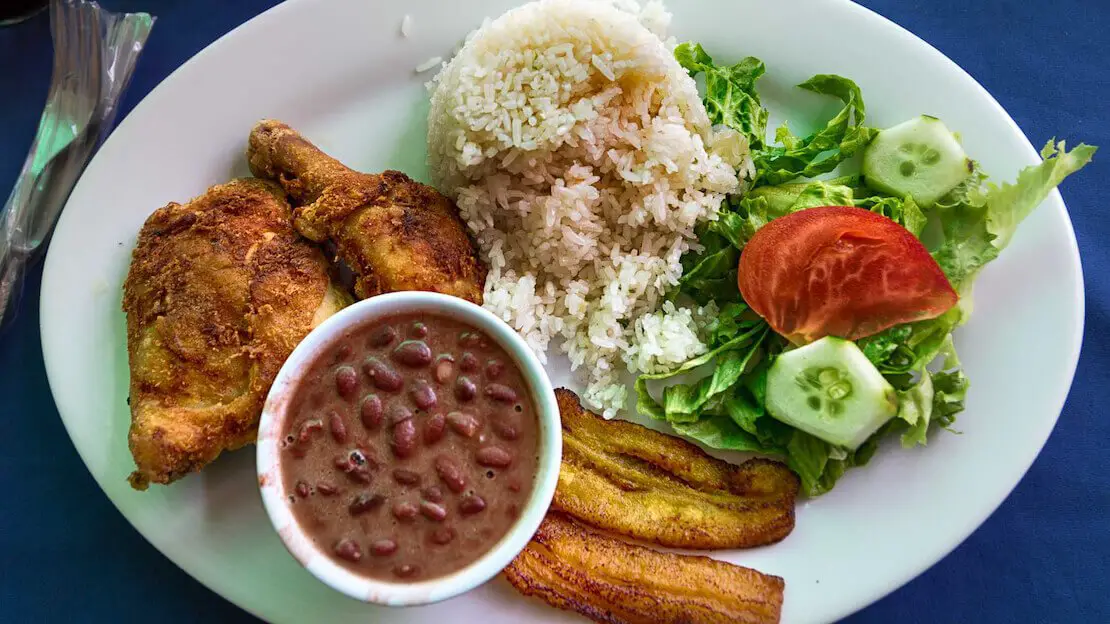
Plato casado.
Cost of transportation in Costa Rica
Public transportation is quite inexpensive. Buses cost about $1-2 per hour. There are shuttles between major tourist destinations that operate with door-to-door service. They can be booked through hostels/hotels and are undoubtedly a more convenient and faster way to get from one place to another but also significantly more expensive than public transport, three even four times more. The few internal flights that exist are also quite expensive and have fixed prices, a San Jose – Tortuguero flight for example costs around $100 versus $10 for the bus. Here you can find some prices just to get an idea.
Travel to Costa Rica: safety
Costa Rica is definitely safe, arguably the safest country in all of Central America. However, as with any other part of the world, it’s important to use common sense. For example, walking around at night on a deserted street in San José could lead to trouble.
When traveling, never lose sight of your luggage on buses or at bus terminals, and you should generally have no trouble. Tap water is also typically safe to drink, at least in most areas, unless you are in a very isolated location.
Are you planning a trip to Costa Rica? Check out these posts:
Do you have any questions? Updated information? Feel free to leave a comment or message me on Instagram!
If you found this article helpful, please consider purchasing your travel insurance through one of the links on this site, doing so supports my work at no additional cost to you. For EU & UK Residents, i recommend True Traveller. For everyone else i recommend HeyMondo (5% discount). Thanks!
For donations/pizzas and virtual beers 🙂
Did you like the post? Pin it!
